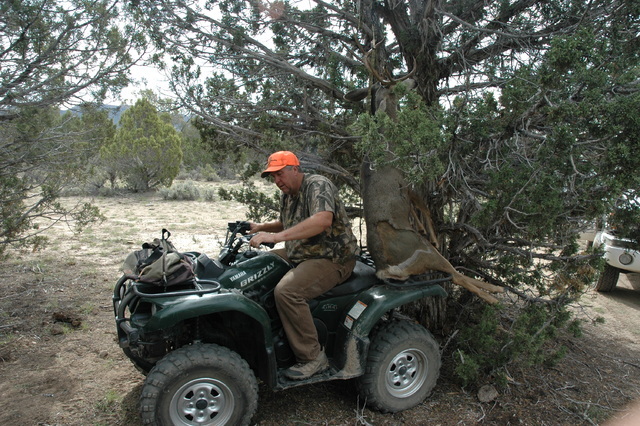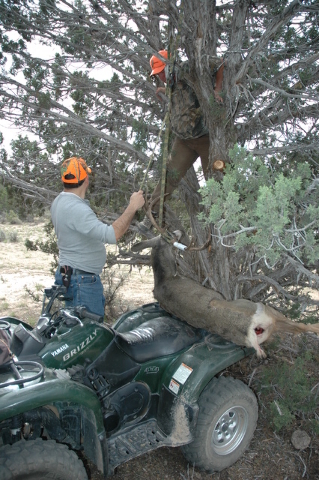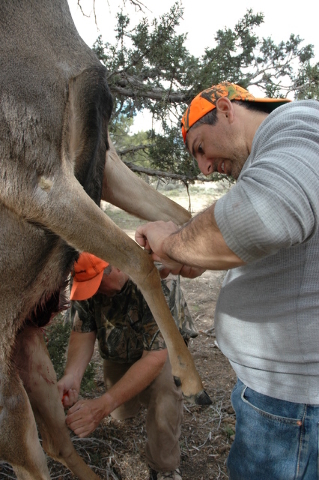Field dressing a big-game animal is an essential task for hunters




“Ya got him! Ya got him!” Hyrum yelled as he pushed the truck door open and ran toward the dirt mound where seconds before a buck antelope was standing guard over his harem.
Despite my frantic efforts to slow him down, there was no stopping him.
The excited 8-year-old was on a mission, and all I could do was hope for the best as he hurried through the waste-high brush in search of the antelope, yelling “Ya got him, Dad!”
Luckily, my shot was true, and the .130-grain bullet had done its job quickly. We spent a few minutes taking pictures, then it was time for the next step, field dressing the antelope.
Field dressing a big-game animal is never pleasant, but it is essential. In fact, it is the first step toward turning the animal into tasty table fare and preserving the hide if you want to have the animal mounted. For either purpose, timing is critical.
One October while assisting with a chronic wasting disease checkpoint in Alamo, a man pulled up with a cow elk on a flatbed trailer. The animal had not been field dressed, not even gutted. The afternoon temperature was quite warm, and the sun had been beating down on that elk all the way from somewhere near Ely.
The animal already was swollen, and any hope of using the meat was gone. I asked why he hadn’t field dressed the animal. He said he didn’t know how and was just taking it to the butcher. I’m glad I wasn’t his butcher.
In field dressing an animal, experienced hunter have their own ways of doing things. I begin by gutting the animal. Many hunters today are using a gutless method. Both can be learned by watching videos on the internet. Back in my day, someone showed us or we learned by trial and sometimes by error.
The key is to keep your game meat cool, clean and dry. An animal’s hide is its insulation — keeping heat in and cold out — and you need to remove it as soon as possible. When hunting deer, my friends and I gut the animal and head for camp as soon as possible. Immediately upon arrival, we hang the animal, skin it and wipe it with a damp cloth to remove any dirt or hair.
For those who bone the animal or choose to quarter it in the field, the principle is still the same. Get the hide off and cool it down.
Next we slide a quality game bag over the carcass to keep dust and flies off; skip the cheap bags that don’t do that job. Some years ago I read a tip that has really paid off. I use a bag made of a twin-size, cotton bed sheet.
It is folded in half lengthwise and sewn to create a bag. It lets air through, which keeps the carcass cool, but keeps flies and dirt out. And it is long enough to cover even a large deer.
Don’t use plastic bags because they will hold heat in.
Flies are sneaky and will get into your meat any way they can, even through the animal’s nostrils. Removing the head from the carcass enables you to secure the game bag and keep flies out.
During the past few years, keeping an animal carcass cool has been a challenge because of unseasonably warm temperatures. If nighttime temperatures drop to freezing and the daytime remains cool enough, hanging the carcass in the shade might be enough to protect your meat for a few days. If not, you may need to head for the butcher right away.
You also might get some help from an old sleeping bag, which can act as an insulator to help keep the carcass cool during the day. Wrap the carcass in the sleeping bag first thing in the morning, then removed the sleeping bag at night. Repeat as necessary.
If you bone the animal and place the meat in game bags, be sure to spread the meat out or rotate it periodically to ensure it all cools down.
Otherwise a warm spot can cause spoilage, even in a cooler.
Once you get to the point where you put your meat in a cooler, keep in mind the need to keep the meat dry.
Use milk jugs that have been filled with water and frozen. If you plan to bring the carcass home in one piece, place it where it will be out of the sun, travel while it is cool and make a beeline for the meat packer or wherever you do the butchering.
Then freeze your meat and enjoy it throughout the year.
Freelance writer Doug Nielsen is a conservation educator for the Nevada Department of Wildlife. His “In the Outdoors” column, published Thursday in the Las Vegas Review-Journal, is not affiliated with or endorsed by the NDOW. Any opinions he states in his column are his own. He can be reached at intheoutdoorslv@gmail.com.












